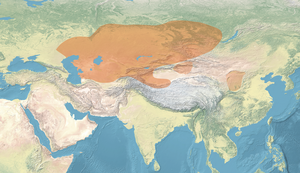
The Sarmatians were a large confederation of ancient Eastern Iranian equestrian nomadic peoples of classical antiquity who dominated the Pontic steppe from about the 3rd century BC to the 4th century AD.
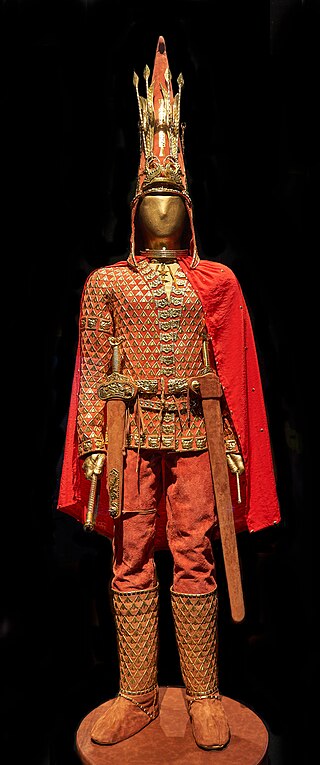
The Saka, Shaka, or Sacae were a group of nomadic Eastern Iranian peoples who historically inhabited the northern and eastern Eurasian Steppe and the Tarim Basin.
The Pazyryk culture is a Saka nomadic Iron Age archaeological culture identified by excavated artifacts and mummified humans found in the Siberian permafrost, in the Altay Mountains, Kazakhstan and nearby Mongolia. The mummies are buried in long barrows similar to the tomb mounds of Scythian culture in Ukraine. The type site are the Pazyryk burials of the Ukok Plateau. Many artifacts and human remains have been found at this location, including the Siberian Ice Princess, indicating a flourishing culture at this location that benefited from the many trade routes and caravans of merchants passing through the area. The Pazyryk are considered to have had a war-like life. The Pazyryk culture was preceded by the "Arzhan culture".

The Ordos culture was a material culture occupying a region centered on the Ordos Loop during the Bronze and early Iron Age from c. 800 BCE to 150 BCE. The Ordos culture is known for significant finds of Scythian art and may represent the easternmost extension of Indo-European Eurasian nomads, such as the Saka, or may be linkable to Palaeo-Siberians or Yeniseians. Under the Qin and Han dynasties, the area came under the control of contemporaneous Chinese states.
Arzhan is a site of early Saka kurgan burials in the Tuva Republic, Russia, some 60 kilometers (40 mi) northwest of Kyzyl. It is on a high plateau traversed by the Uyuk River, a minor tributary of the Yenisei River, in the region of Tuva, 20 km to the southwest of the city of Turan.
The Barrowsof Tasmola are dispersed throughout central Kazakhstan in the Karaganda, Akmola, and Pavlodar regions.
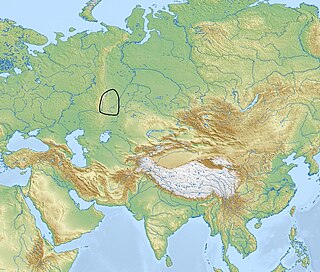
The Sintashta culture is a Middle Bronze Age archaeological culture of the Southern Urals, dated to the period c. 2200–1900 BCE. It is the first phase of the Sintashta–Petrovka complex, c. 2200–1750 BCE. The culture is named after the Sintashta archaeological site, in Chelyabinsk Oblast, Russia, and spreads through Orenburg Oblast, Bashkortostan, and Northern Kazakhstan. The Sintashta culture is thought to represent an eastward migration of peoples from the Corded Ware culture. It is widely regarded as the origin of the Indo-Iranian languages, whose speakers originally referred to themselves as the Arya. The earliest known chariots have been found in Sintashta burials, and the culture is considered a strong candidate for the origin of the technology, which spread throughout the Old World and played an important role in ancient warfare. Sintashta settlements are also remarkable for the intensity of copper mining and bronze metallurgy carried out there, which is unusual for a steppe culture. Among the main features of the Sintashta culture are high levels of militarism and extensive fortified settlements, of which 23 are known.

The Slab-Grave culture is an archaeological culture of Late Bronze Age and Early Iron Age Mongolia. The Slab-Grave culture formed one of the primary ancestral components of the Xiongnu, as revealed by genetic evidence. The ethnogenesis of Turkic peoples and the modern Mongolian people is, at least partially, linked to the Slab-Grave culture by historical and archaeological evidence. and further corroborated by genetic research on the Slab Grave remains.

The Aldy-Bel culture was part of Uyuk culture, and is an Iron Age culture of Scytho-Siberian horse nomads in the area of Tuva in southern Siberia, dated to the 8th to 6th centuries BCE.
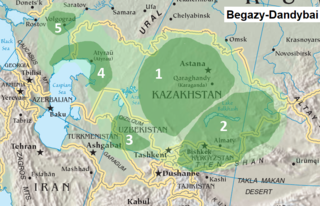
Begazy-Dandybai culture is a late Bronze Age culture of mixed economy in the territory of ancient central Kazakhstan, Kyrgyzstan, and Uzbekistan, centered at Saryarka region. The culture, with its megalithic mausolea dates from c. 1350-1150 BCE, but was previously dated between the 12th and 8th centuries BCE, or from 13th to 10th centuries BCE. The culture was discovered, first excavated, and published in the 1930s-1940s by M.P. Gryaznov, who took it for a local version of Karasuk culture. In 1979 the Begazy-Dandybai culture was described and analyzed in detail in a monograph by A.Kh. Margulan, who systematically reviewed accumulated material and produced description of the archeological culture. The most famous monuments of Begazy-Dandybai culture are Begazy, Dandybai, Aksu Ayuly 2, Akkoytas, and Sangria 1.3, it was named after the first two archeological sites.
The Tasmola culture was an early Iron Age culture during the Saka period in central Kazakhstan. The Tasmola culture was replaced by the Korgantas culture. They may correspond to the Issedones of ancient Greek sources.
The origin of the Huns and their relationship to other peoples identified in ancient sources as Iranian Huns such as the Xionites, the Alchon Huns, the Kidarites, the Hephthalites, the Nezaks, and the Huna, has been the subject of long-term scholarly controversy. Ancient Greek and Roman sources do not provide any information on where the European Huns came from, besides that they suddenly appeared in 370 CE. However, there are some possible mentions of the Huns or tribes related to them that pre-date 370. Chinese sources, meanwhile, indicate several different, sometimes contradictory origins for the various "Iranian Hun" groups. In 1757, Joseph de Guignes first proposed that the Huns and the Iranian Huns were identical to the Xiongnu. The thesis was then popularized by Edward Gibbon. Since that time scholars have debated the proposal on its linguistic, historical, and archaeological merits. In the mid-twentieth century, the connection was attacked by the Sinologist Otto J. Maenchen-Helfen and largely fell out of favor. Some recent scholarship has argued in favor of some form of link, and the theory returned to the mainstream, but there is no consensus on the issue. It also remains disputed whether the various “Iranian Huns” belonged to a single or multiple ethnic groups.

The Scytho-Siberian world was an archaeological horizon which flourished across the entire Eurasian Steppe during the Iron Age from approximately the 9th century BC to the 2nd century AD. It included the Scythian, Sauromatian and Sarmatian cultures of Eastern Europe, the Saka-Massagetae and Tasmola cultures of Central Asia, and the Aldy-Bel, Pazyryk and Tagar cultures of south Siberia.
Sargat culture, was a sedentary archaeological culture that existed between 7th century BC and 5th century AD in Western Siberia. Sargat cultural horizon encompassed northern forest steppe zone between the Tobol and Irtysh rivers, which is currently located in Russia and Kazakhstan. The northernmost Sargat culture presence is found near Tobolsk, on the border of the forest zone. In the south, the area of culture coincides with the southern border of the forest-steppe. Eastern foothills of the Urals make up the western boundary of the culture, meanwhile Baraba forest-steppe forms the eastern edge for Sargat settlements and burial grounds. The culture is named after the village of Sargatskoye, which is located near a Sargat burial ground.
The Sauromatian culture was an Iron Age culture of horse nomads in the area of the lower Volga River to the southern Ural Mountain, in southern Russia, dated to the 6th to 4th centuries BCE. Archaeologically, the Sauromatian period itself is sometimes also called the "Blumenfeld period", and is followed by a transitional Late Sauromatian-Early Sarmatian period, also called the "Prokhorov period".

In archaeogenetics, the term Ancient Northeast Asian (ANA), also known as Amur ancestry, is the name given to an ancestral component that represents the lineage of the hunter-gatherer people of the 7th-4th millennia before present, in far-eastern Siberia, Mongolia and the Baikal regions. They are inferred to have diverged from Ancient East Asians about 24kya ago, and are represented by several ancient human specimens found in archaeological excavations east of the Altai Mountains. They are a sub-group of the Ancient Northern East Asians (ANEA).
The Subeshi culture, also Subeishi or Subeixi culture, is an Iron Age culture from the area of Shanshan County, Turfan, Xinjiang, at the eastern edge of the Tarim Basin. The Subeshi culture contributes some of the later period Tarim Mummies. It might be associated with the Cheshi state known from Chinese historical sources. The culture includes three closely related cemeteries:

The Filippovka kurgans are Late-Sauromatian to Early-Sarmatian culture kurgans, forming "a transition site between the Sauromation and the Sarmatian epochs", just north of the Caspian Sea in the Orenburg region of Russia, dated to the second half of the 5th century and the 4th century BCE.
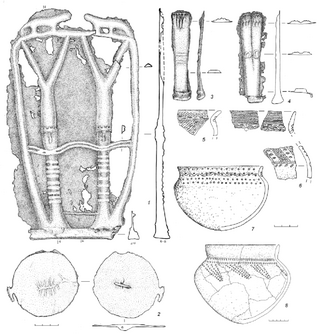
The Itkul culture is one of these Early Saka culture, based in the eastern foothills of the Urals. The Itkul culture was part of an East to West mouvement of Asiatic Saka tribes towards the Ural regions during the Iron Age period. Other Saka groups, such as the Tasmola culture circa 600 BCE, were also involved in similar mouvements and settled in the southern Urals.

The Araltobe kurgan is a burial ground found near Araltobe, Zhylyoi District, in northwestern Kazakhstan, thought to belong to a member of the post-Saka Sarmatian culture, and dated to the 3rd-2nd century BCE.

